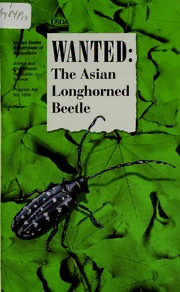
Wanted, the Asian longhorned beetle PDF
Preview Wanted, the Asian longhorned beetle
Historic, Archive Document Do assume not content reflects current scientific knowledge, policies, or practices. 1 ed States irtjTient of WANTED: riculture K Animal and ^lypHealth The Asian In^^ction ^ ^ 'ice Longhomed rOgram Aid Na 1655 ^ Beetle TheU.S. DepartmentofAgriculture (USDA)prohibits discriminationinallits programs and activities onthebasis ofrace, color, national origin, sex, religion, age, disability, politicalbeliefs, sexualorientation, ormaritalorfamily status. (Notall prohibitedbases applyto allprograms.) Personswithdisabilities whorequirealterna- tivemeans forcommunicationofprograminformation (Braille, largeprint, audiotape, etc.) shouldcontactUSDA'sTARGETCenterat(202) 720-2600 (voice andTDD). Tofileacomplaintofdiscrimination, writeUSDA, Director, OfficeofCivilRights, Room326-W,WhittenBuilding, 1400IndependenceAvenue, SW,Washington, DC 20250-9410orcall (202) 720-5964 (voice andTDD). USDAis anequalopportunity providerandemployer. RevisedJune2001 Photo credits: Imagesinfigures 1, 3, 4, 8, 10, and 11 weretakenbyAPHIS photog- rapherKenLaw. Thoseinfigures 2 and9 comefi*omtheAPHIS photolibrary. Photosinfigures 5-7 weretakenbyAPHIS photographerDanielJ. Parry. Introduction TheAsian longhomed beetle (Anoplophora glabripennis) has earned the title ofpest both here and in its home country ofChina. This beetle is a serious threat to hardwood trees and has no known natural predator in the United States. IftheAsian longhomed beetle becomes estabUshed here, it has the potential to cause more damage than Dutch elm disease, chestnut bUght, and the gypsy moth combined, destroying miUions ofacres ofAmerica's treasured hardwoods, including nation- al forests andbackyard trees. The beetle has the potential to damage such industries as lumber, furniture, maple syrup, nursery, and tourism. But thanks to observant homeowners in both Chicago and NewYork, the beetle's sneak attack on the United States has been thwarted. The U.S. Depart- mentofAgriculture's (USDA) Animal and Plant Health Inspection Service (APHIS), together with State and local governments and local residents, works dihgently to halt the spread ofthis devastating pest. However, in order to be completely successful, USDA's eradica- tion efforts must have the cooperation ofeveryone. — Figure 1 ^This photoillustrates anadult Asianlonghomedbeetle and severalholes boredbylarvae. 3 The Beetle Asian longhomed beetles are about 1 to 1.5 inches long, are shiny and black with white spots, and have long antennae that are banded with black and white. They attackmany differenthardwood trees, including maple (Norway, sugar, silver, red, and boxelder), birch, horsechestnut, poplar, willow, elm, ash, and black locust. Individual beetles typically attack a single host tree but migrate to nearby host trees when beetle populations become too dense. FemaleAsian longhomedbeetles chew depressions (oviposition sites) in the bark oftrees to lay eggs. One female can lay 35 to 90 eggs. Hatching within 10 to 15 days, the white, wormlike grubs develop into caterpillars (larvae) and tunneljustbeneath the tree barkin the cambi- um layer. They feed in the cambium for several weeks before entering woody tree tissue (xylem). There the larvae continue to feed and develop during the winter. Beetle larvae pupate through the spring inside host trees. During summer, the adult beetles emerge, mate, and feed on the bark ofsmall twigs for several days. Adultbeetles remain active only during summer and early fall months before perishing. — Figure2 IftheAsianlonghomedbeetlebecomes established here, ithas thepotentialtocausemoredamagethanDutchelm disease, chestnutbUght, andthegypsymothcombined. 4 — Figure3 ^Asianlonghomedbeetledamage. Battling the Beetle TheAsian longhomed beetle's life cycle makes conventional insect eradication measures such as pesticides ineffective. Because the majority ofthe beetle's life is spent deep within the host tree, surface- applied insecticides are not an option. Atpresent, the only effective method ofeliminating the beetle is to cut, chip, or bum infested trees and replace them with nonhost species. Research to find better control options is ongoing. Scientists are experimenting with traps using sex attractants — (pheromones) an approach that has worked well for the — gypsy moth and iniiii^iiiiiiffii — using host-plant Figure 4 ^Asianlonghomedbeetlelarva. (tree) odors to aid in locating infested trees. Researchers are also studying the efficacy of insecticides deliv- ered directly into host trees via small injection capsules. In the absence ofa trap, APHIS and cooperating State — Figure 5 Insecticidesinjectedintotrees viasmall inspectors must injectioncapsulesthen spreadsystemicallythrough tackle the difficult thewood,killinginsects infestingthatwood. task ofcompleting 6 — a survey ofbeetle- infested areas by individually examining trees for signs ofbeetle damage. Many Federal agencies contribute resources to USDA's tree inspection effort APfflS, the Forest Service, the Bureau ofLand Management, and USDA's Agricultural Marketing Service. State and local government coop- erators include the NewYork State Department of — Agriculture and Figure 6 ^Aerialtreeinspections areperformed Markets NewYork trainedprofessionals usingbuckettrucks. City Department ofParks and Recreation, Illinois Department ofAgriculture, Chicago Department of Streets and Sanitation, and Chicago Bureau ofForestry. These agencies also contract with local tree service professionals. Inspectors search for beetle exit holes, oviposition sites, and piles of frass (insect waste and sawdust) at the base ofinfested trees and in branch crotches. Sap flows may also indicateAsian longhomed beetle wounds in infested trees. Unseasonable yellowing or drooping of leaves when the weather has not been especially dry are also signs 7 that the Asian longhorned beetle is present. Leaf symptoms show up when the immature inseets, growing inside the tree, have bored through tissues that earry water (xylem) from tree roots and nutrients (phloem) from the leafy eanopy above. Onee the pest has suffieiently disrupted those pathways, the infested braneh or the entire tree will die. Inspeetors utili/e innovative methods to eonduet Asian longhorned beetle surveys. lYained professionals perform aerial tree inspeetions using bueket trueks, and Forest Serviee and Bureau of Land Management smokejumpers (forest tlretlghters) elimb trees in diffieult areas. Cuound observations involve the partieipation of many interest groups and organizations; however, anyone with a keen eye and set of binoculars can contribute to this effort. Fijjure 7 In difficult areas, sniokojunipLMS (forest firefighters) tioin the USOA iHMOst Sor\ico and the U.S. Dopiutment ofthe Interior's Bureau of1.and Management elimb trees to inspect for Asian longhorned beetles. 8
